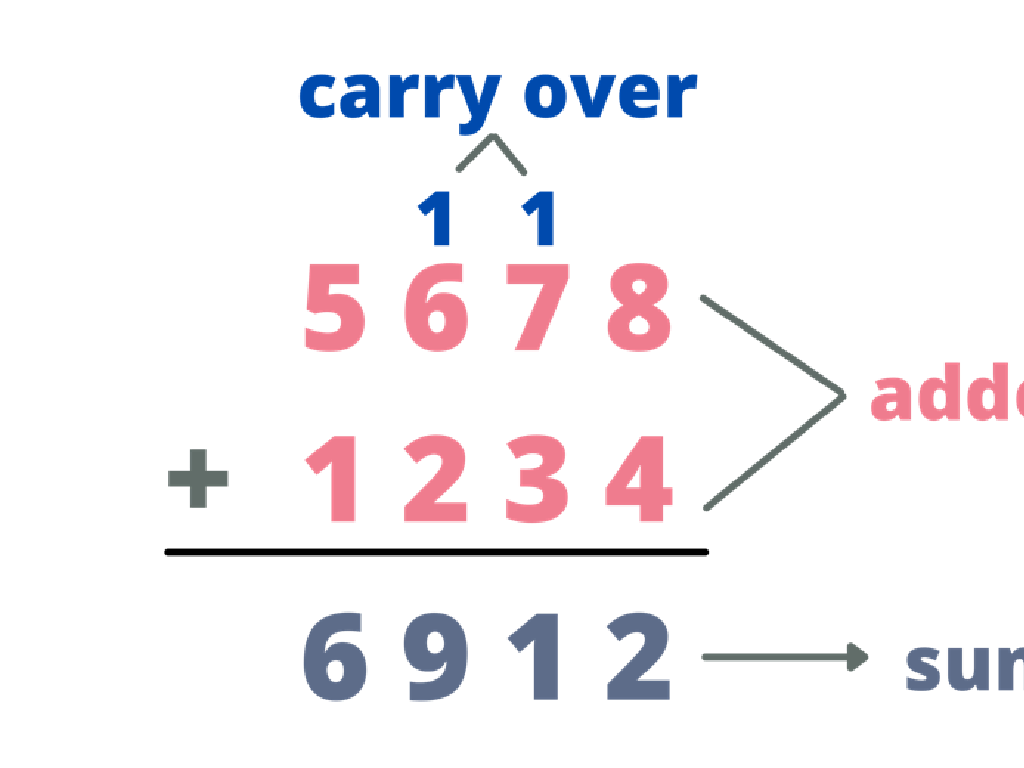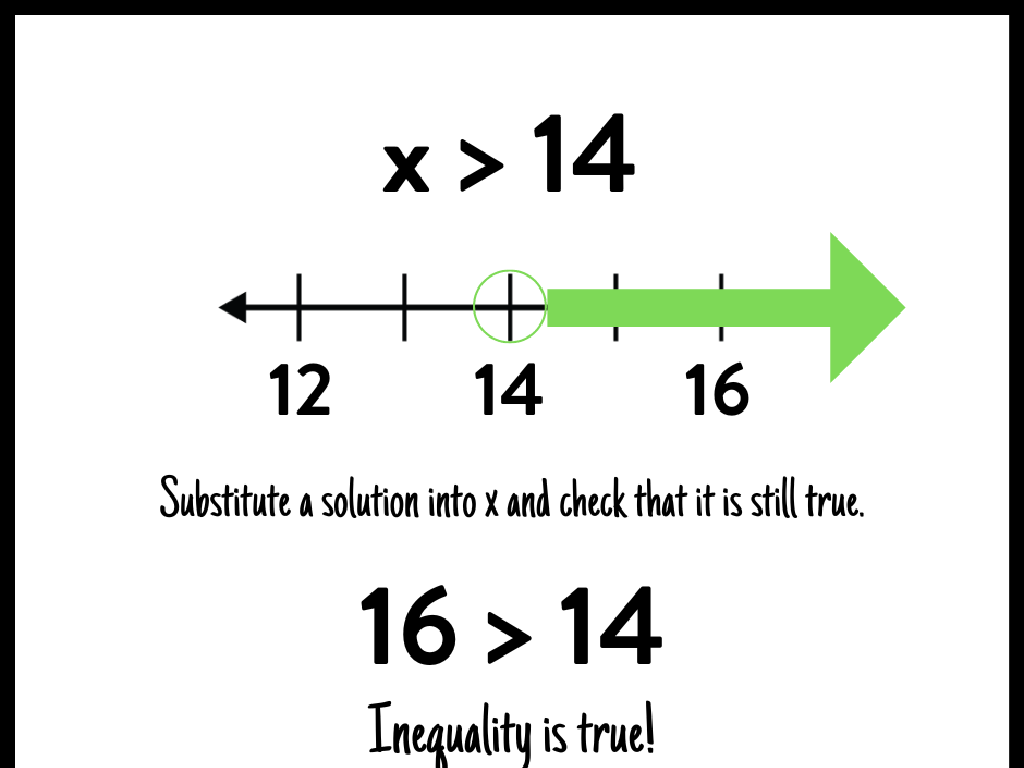Perimeter: Find The Missing Side Length
Subject: Math
Grade: Third grade
Topic: Perimeter
Please LOG IN to download the presentation. Access is available to registered users only.
View More Content
Welcome to Perimeter Exploration!
– Perimeter is the border length
– How to calculate perimeter?
– Add up all the side lengths of a shape
– Perimeter’s role in real life
– Used in everyday tasks like fencing a yard
– Finding missing side lengths
– Use the total perimeter to solve for unknown sides
|
This slide introduces the concept of perimeter to third-grade students. Begin by explaining that perimeter is the total length around the edge of a shape. Show them how to calculate the perimeter by adding the lengths of all sides. Discuss why perimeter is important, such as determining the amount of fencing needed for a garden. Finally, demonstrate how to find the length of a missing side when the total perimeter is known, using simple shapes like rectangles. Encourage students to think of perimeter as a fence around a shape, which can make the concept more relatable and easier to grasp.
Exploring Perimeters: Finding Missing Sides
– Perimeter: total distance around
– Like a fence around a yard!
– Calculate by adding all sides
– Add lengths of every side together
– Use known sides to find missing
– Subtract known lengths from total perimeter
– Practice with different shapes
– Try rectangles, squares, and triangles
|
This slide introduces the concept of perimeter to third-grade students, explaining it as the total distance around a shape, akin to the length of a fence surrounding a yard. Emphasize that calculating perimeter involves adding the lengths of all the sides of the shape. When a side length is missing, students can find it by subtracting the sum of the known sides from the total perimeter. Encourage practice with various shapes to solidify understanding. Provide examples and guide students through solving problems where they have to find a missing side length given the perimeter.
Finding the Perimeter of a Rectangle
– Perimeter equals two times (length plus width)
– Example: Length = 5 cm, Width = 3 cm
– A rectangle’s sides: two lengths and two widths
– Calculate: 2 x (5 cm + 3 cm)
– Add length and width, then multiply by 2
– Perimeter of this rectangle is 16 cm
– 2 x 8 cm = 16 cm, so the perimeter is 16 cm
|
This slide introduces students to the concept of finding the perimeter of a rectangle. Start by explaining the formula for the perimeter of a rectangle, which is 2 times the sum of its length and width. Use a simple example with whole numbers to illustrate the concept. For instance, if the length is 5 cm and the width is 3 cm, students should first add the length and width to get 8 cm and then multiply by 2 to find the perimeter, which is 16 cm. Encourage students to practice with different lengths and widths and to check their understanding by calculating the perimeter of various rectangles.
Finding the Missing Side Length
– Understand the total perimeter
– Add the lengths of known sides
– Subtract known total from perimeter
– If perimeter is 20 cm and 3 sides are 5 cm, 4 cm, and 6 cm, what’s the fourth side?
– Solve for the missing side
– Use subtraction: 20 cm – (5 cm + 4 cm + 6 cm) = 5 cm for the missing side
|
This slide is aimed at teaching students how to calculate the length of a missing side in a shape when the total perimeter is known. Start by ensuring students understand the concept of perimeter as the total distance around the shape. Then, guide them to add up the lengths of the sides that they know. Once they have this total, they should subtract it from the overall perimeter to find the length of the missing side. Use the example provided to illustrate this process step by step. Encourage students to practice with different shapes and perimeters to solidify their understanding.
Let’s Practice Perimeter!
– Example 1: Rectangle with 18 cm perimeter
– If one side is 5 cm, the opposite is also 5 cm. What are the other sides?
– Example 2: Square with 16 cm perimeter
– All sides of a square are equal. What’s the length of one side?
|
This slide is designed for a class activity where students will apply their knowledge of perimeter to find missing side lengths. For the rectangle, guide them to understand that opposite sides are equal and use this to solve for the missing lengths. For the square, reinforce the concept that all sides are equal in length. Provide additional examples if time allows, such as different rectangles or squares with various perimeters. Encourage students to explain their thought process as they solve each example. This will help them to articulate their understanding and demonstrate their problem-solving skills.
Your Turn to Solve: Finding Missing Sides
– Activity: Calculate missing sides
– Work together in pairs
– Partner up and help each other out
– Discuss your solutions
– Talk about how you got your answers
– Share with the class
– Be prepared to present your findings
|
This slide introduces an interactive class activity where students will apply their knowledge of perimeter to find missing side lengths on various shapes. Students should work in pairs to encourage collaboration and problem-solving skills. Provide them with a worksheet containing different shapes with one or more sides missing and the total perimeter. Encourage them to use subtraction to solve for the unknown lengths. After completing the activity, students will discuss their methods and solutions with their partner, ensuring they understand the process. Finally, select a few pairs to share their answers with the class to reinforce learning and celebrate their success. Possible activities can include finding missing sides of rectangles, squares, and triangles with different given perimeters.
Class Activity: Perimeter Puzzle
– Understand the Perimeter Puzzle
– Each group gets a puzzle sheet
– Shapes with one or more sides missing
– Find missing side lengths
– Use perimeter formulas and clues
– Complete the puzzle as a team
|
This interactive class activity is designed to help students apply their knowledge of perimeter in a fun and engaging way. Divide the class into small groups and provide each group with a puzzle sheet that includes various shapes with missing side lengths. Students must use the sum of the known sides and the total perimeter to find the missing lengths. Encourage collaboration within the groups and provide guidance as needed. Possible variations of the activity could include different shapes (rectangles, squares, triangles), using string to measure sides, or creating their own shapes for classmates to solve. This hands-on experience reinforces the concept of perimeter and the importance of teamwork.
Becoming a Perimeter Pro!
– Congratulations on your hard work!
– Recall the steps to find perimeter
– Add up all the side lengths, or use the formula: Perimeter = 2*(length + width)
– Practice makes perfect
– Try with different shapes and sizes
– You’re on your way to mastery!
|
This slide is meant to congratulate the students on their effort and progress in learning how to find missing side lengths when calculating the perimeter. It’s important to recap the steps they’ve learned, reinforcing the method of adding all the side lengths together or using the formula for rectangles. Encourage them to continue practicing with a variety of shapes and sizes to solidify their understanding. Remind them that with consistent practice, they will become proficient in finding perimeters, which is a fundamental skill in geometry.





 14′ />
14′ /> 